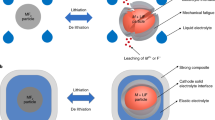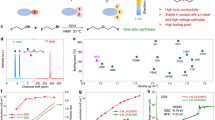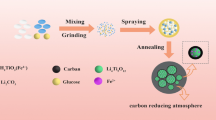Abstract
Li-ion batteries have empowered consumer electronics and are now seen as the best choice to propel forward the development of eco-friendly (hybrid) electric vehicles. To enhance the energy density, an intensive search has been made for new polyanionic compounds that have a higher potential for the Fe2+/Fe3+ redox couple. Herein we push this potential to 3.90 V in a new polyanionic material that crystallizes in the triplite structure by substituting as little as 5 atomic per cent of Mn for Fe in Li(Fe1−δMnδ)SO4F. Not only is this the highest voltage reported so far for the Fe2+/Fe3+ redox couple, exceeding that of LiFePO4 by 450 mV, but this new triplite phase is capable of reversibly releasing and reinserting 0.7–0.8 Li ions with a volume change of 0.6% (compared with 7 and 10% for LiFePO4 and LiFeSO4F respectively), to give a capacity of ~125 mA h g−1.
This is a preview of subscription content, access via your institution
Access options
Subscribe to this journal
Receive 12 print issues and online access
$259.00 per year
only $21.58 per issue
Buy this article
- Purchase on Springer Link
- Instant access to full article PDF
Prices may be subject to local taxes which are calculated during checkout






Similar content being viewed by others
References
Armand, M. & Tarascon, J-M. Building better batteries. Nature 451, 652–657 (2008).
Tarascon, J-M. & Armand, M. Issues and challenges facing rechargeable lithium batteries. Nature 414, 359–367 (2001).
Yamada, A. et al. Lithium iron borates as high capacity battery electrodes. Adv. Mater. 22, 3583–3587 (2010).
Nyten, A., Abouimrane, A., Armand, M., Gustafsson, T. & Thomas, J.O. Electrochemical performance of Li2FeSiO4 as a new Li-battery cathode material. Electrochem. Commun. 7, 156–160 (2005).
Nishimura, S. et al. Structure of Li2FeSiO4 . J. Am. Chem. Soc. 130, 13212–13213 (2008).
Nishimura, S., Makamura, M., Natsui, R. & Yamada, A. New lithium iron pyrophosphate as 3.5 V class cathode material for lithium ion battery. J. Am. Chem. Soc. 132, 13596–13597 (2010).
Barker, J., Saidi, M. Y. & Swoyer, J. L. A comparative investigation of the Li insertion properties of the novel fluorophosphate phases, NaVPO4F and LiVPO4F. J. Electrochem. Soc. 151, 1670–1677 (2004).
Padhi, A. K., Nanjundaswamy, K. S. & Goodenough, J. B. Tuning the position of the redox couples in materials with NASICON structure by anionic substitution. J. Electrochem. Soc. 145, 1518–1520 (1998).
Recham, N. et al. A 3.6 V lithium-based fluorosulphate insertion positive electrode for lithium-ion batteries. Nature Mater. 9, 68–74 (2010).
Barpanda, P. et al. Structure and electrochemical properties of novel mixed Li(Fe1−xMx)SO4F (M=Co, Ni) phases fabricated by low temperature ionothermal synthesis. J. Mater. Chem. 20, 1659–1668 (2010).
Rea, J. R. & Kostiner, E. The crystal structure of manganese fluorophosphate, Mn2(PO4)F. Acta Crystallogr. B 28, 2525–2529 (1972).
Recham, N. et al. Ionothermal synthesis of tailor-made LiFePO4 powders for Li-ion battery applications. Chem. Mater. 21, 1096–1107 (2009).
Ati, M. et al. Fluorosulphate positive electrodes for Li-ion batteries made via a solid-state dry process. J. Electrochem. Soc. 157, 1007–1015 (2010).
Barpanda, P. et al. Structural and electrochemical investigation of novel AMSO4F(A=Na,Li;M=Fe,Co,Ni,Mn) metal fluorosulphates prepared using low temperature synthesis routes. Inorg. Chem. 49, 7401–7413 (2010).
Barpanda, P. et al. LiZnSO4F made in an ionic liquid: A new ceramic electrolyte composite for solid-state Li-batteries. Angew. Chem. Int. Ed. 50, 2526–2531 (2010).
Ati, M. et al. Fluorosulfate positive electrode materials made with polymers as reacting media. Electrochem. Solid-State. Lett. 13, 150–153 (2010).
Rodrı´guez-Carvajal, J. Recent advances in magnetic structure determination by neutron powder diffraction. Physica B 192, 55–69 (1993).
Shannon, R. D. & Prewitt, C. T. Effective ionic radii in oxides and fluorides. Acta. Cryst B25, 925 (1969).
Tarantino, S. C., Ghigna, P., McCammon, C., Amantea, R. & Carpenter, M. A. Local structure properties of (Mn,Fe)Nb2O6 from Mössbauer and X-ray absorption spectroscopy. Acta Cryst. B 61, 250–257 (2005).
Hanaor, D. & Sorrell, C. Review of the anatase to rutile phase transformation. J. Mater. Sci. 46, 1–20 (2011).
Frayret, C. et al. LiMSO4F (M=Fe, Co, and Ni): Promising new positive electrode materials through the DFT microscope. Phys. Chem. Chem. Phys. 12, 15512–15522 (2010).
Cai, Y. et al. First-principles calculations on the LiMSO4F/MSO4F (M=Fe, Co, and Ni) systems. J. Phys. Chem. C 115, 7032–7037 (2011).
Ramzan, M., Lebegue, S., Kang, T. W. & Ahuja, R. Hybrid density functional calculations and molecular dynamics study of lithium fluorosulphate, a cathode material for lithium-ion batteries. J. Phys. Chem. C 115, 2600–2603.
Tripathi, R., Gardiner, G. R., Islam, M. S. & Nazar, L. F. Alkali-ion conduction paths in LiFeSO4F and NaFeSO4F tavorite-type cathode materials. Chem. Mater. 23, 2278–2284 (2011).
Liu, Z. & Huang, X. Structural, electronic, and Li diffusion properties of LiFeSO4F. Solid State Ion. 181, 57–61 (2010).
Sirisopanaporn, C., Masquelier, C., Bruce, P., Armstrong, A. & Dominko, R. Dependence of Li2FeSiO4 electrochemistry on structure. J. Am. Chem. Soc. 133, 1263–1265 (2011).
Favre-Nicolin, V. & Cerny, R. Fox, ‘free objects for crystallography’: A modular approach to ab initio structure determination from powder diffraction. J. Appl. Cryst. 35, 734–743 (2002).
Varret, F. & Teillet, J. Unpublished Mosfit Program (Universite du Maine, 1976).
Dent, A. J. B18: A core XAS spectroscopy beamline for diamond. J. Phys. Conf. Ser. 190, 012039 (2009).
Webb, S. M. SIXPack: A graphical user interface for XAS analysis using IFEFFIT. Phys. Scr. T115, 1011–1014 (2005).
Leriche, J. B. et al. An electrochemical cell for operando study of lithium batteries using synchrotron radiation. J. Electrochem. Soc. 157, A606–A610 (2010).
Acknowledgements
Many discussions with M. Armand, N. Recham, C. Delacourt, C. Masquelier, D. Larcher, G. Férey, Y. Chabre, C. Frayret and D.W. Murphy are gratefully acknowledged. We thank C. Davoisne for the TEM images and ALISTORE-ERI for sponsoring this research. Use of the Advanced Photon Source at Argonne National Laboratory was supported by the US Department of Energy, Office of Science, Office of Basic Energy Sciences, under Contract No. DE-AC02-06CH11357. The EXAFS measurements were carried out with the support of the Diamond Light Source and we gratefully acknowledge G. Cibin for help with running the X-ray absorption spectroscopy experiments as well as E. J. Schofield and A. V. Chadwick for discussions in analysing the XANES data.
Author information
Authors and Affiliations
Contributions
P.B., M.A. and J-M.T. carried out the synthesis, the electrochemical work and designed the research approach; B.C.M., G.R. and J-N.C. analysed the crystal structure and diffraction patterns; M.T.S. and J-C.J. collected the Mössbauer measurements; B.C.M. and S.A.C. collected and analysed the EXAFS measurements; M-L.D. conducted the DFT calculations and developed the theoretical framework; B.C.M., G.R. and J-M.T. wrote the manuscript and all authors discussed the experiments and final manuscript.
Corresponding author
Ethics declarations
Competing interests
The authors declare no competing financial interests.
Supplementary information
Supplementary Information
Supplementary Information (PDF 5139 kb)
Rights and permissions
About this article
Cite this article
Barpanda, P., Ati, M., Melot, B. et al. A 3.90 V iron-based fluorosulphate material for lithium-ion batteries crystallizing in the triplite structure. Nature Mater 10, 772–779 (2011). https://doi.org/10.1038/nmat3093
Received:
Accepted:
Published:
Issue Date:
DOI: https://doi.org/10.1038/nmat3093
This article is cited by
-
Fluorophosphates and fluorosulfates cathode materials: Progress towards high energy density sodium-ion battery
Nano Research (2023)
-
Combining intercalation and conversion reversibly
Nature Energy (2022)
-
Amorphous iron fluorosulfate as a high-capacity cathode utilizing combined intercalation and conversion reactions with unexpectedly high reversibility
Nature Energy (2022)
-
Titanium-based potassium-ion battery positive electrode with extraordinarily high redox potential
Nature Communications (2020)
-
Li1.5La1.5MO6 (M = W6+, Te6+) as a new series of lithium-rich double perovskites for all-solid-state lithium-ion batteries
Nature Communications (2020)



